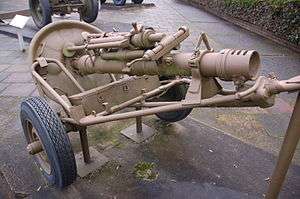M1938 mortar
| 120-PM-38 | |
|---|---|
 A 120-PM-38 on its two-wheeled limber | |
| Type | Mortar |
| Place of origin | Soviet Union |
| Service history | |
| Wars |
World War II Chinese Civil War Korean War First Indochina War Vietnam War Suez Crisis 6 day war Iran-Iraq War |
| Production history | |
| Designed | 1938 |
| Produced | 1939 |
| Specifications | |
| Weight |
travel: 477 kg (1,052 lb) combat: 280 kg (620 lb) |
| Barrel length | 1.86 m (6 ft 1 in) L/15.5[1] |
| Crew | 6 |
|
| |
| Shell | 16 kg (35 lb) |
| Caliber | 120 mm (4.7 in) |
| Breech | muzzle loaded |
| Elevation | +45° to +80° |
| Traverse | 6°[1] |
| Rate of fire | 10 rpm |
| Muzzle velocity | 272 m/s (890 ft/s) |
| Effective firing range | 6 km (3.7 mi)[1] |
The 120-PM-38 or M1938 was a 120 mm Soviet mortar that was used in large numbers by the Red Army during World War II. Although a conventional design its combination of light weight, mobility, heavy firepower and range saw its features widely copied by successive generations of mortars.[2]
Design

The origins of the M1938 lay in the French Mortier Brandt de 120mm Modele 1935 and the Brandt mle 27/31 which the Soviet Union produced under license as the 82-PM-36. In 1937 the Soviets produced a modified version of the 82-PM-36 known as the 82-PM-37 and this mortar served as the pattern for the 120-PM-38. The main difference between the 82-PM-37 and the earlier 82-PM-36 was the adoption of a round base-plate, revised traverse/elevation controls, simplified sights and spring-loaded shock absorbers on the bi-pod to reduce the amount of relaying needed between shots. The 120-PM-38 is essentially a scaled up 82-PM-37 which uses the same two-wheeled limber as the 107 mm PBHM-38. The limber works in much the same way as a hand truck. The limber is wheeled vertically into place, hooks on the base-plate hook onto the limber, the barrel is clamped down and then everything is lowered into towing position. The limber can either be towed directly or attached to a 20-round caisson for towing by a vehicle or horse team.[1]
Employment
The 120-PM-38 was typically deployed to support infantry units and is the heaviest weapon that can still be broken down and transported by soldiers on foot. At first the 120-PM-38 was employed at the regimental level for indirect fire support in place of artillery, but as World War II continued it was issued down to the battalion level to supplement lighter mortars.
Getting the 120-PM-38 into and out of action was relatively rapid, so batteries were often moved to avoid counter-battery fire. Due to its rate of fire and large shell a battery of four mortars could lay down a heavy amount of fire in a short period of time, which was useful for hit and run tactics. Another useful feature was the circular base-plate which allowed for changes in traverse without the need to dig out the base-plate and realign the barrel. Later 120-PM-43 mortars had a larger single shock absorber on the bi-pod to counteract the tendency of the base-plate to dig in on soft ground. 120-PM-43 mortars were kept in production long after World War II and sold to many Soviet client states. Both have seen widespread use in conflicts from World War II until today.[2]
During the early phases of Operation Barbarossa the Germans captured large quantities of Soviet hardware including the 120-PM-38 which they designated the 12 cm Granatwerfer 378(r). After being on the receiving end of the 120-PM-38's firepower they adopted it to supplement their own mortars and eventually produced a modified version called the 12 cm Granatwerfer 42.[1] The Granatwerfer 42 was widely issued to German units and often took the place of infantry guns later in the war.[2] The Finnish and Romanians also made use of captured stocks of Soviet weapons and eventually the Romanians also created their own design, the Reșița Model 1942.
References
External links
- http://www.jaegerplatoon.net/MORTARS0.htm
- https://www.militaryfactory.com/smallarms/detail.asp?smallarms_id=245
- http://weaponsystems.net/weaponsystem/DD01%20-%20M43.html
| Wikimedia Commons has media related to 120 mm mortar M1938. |